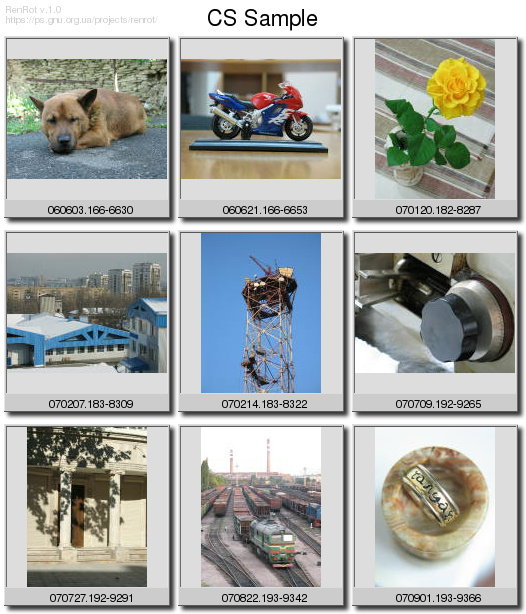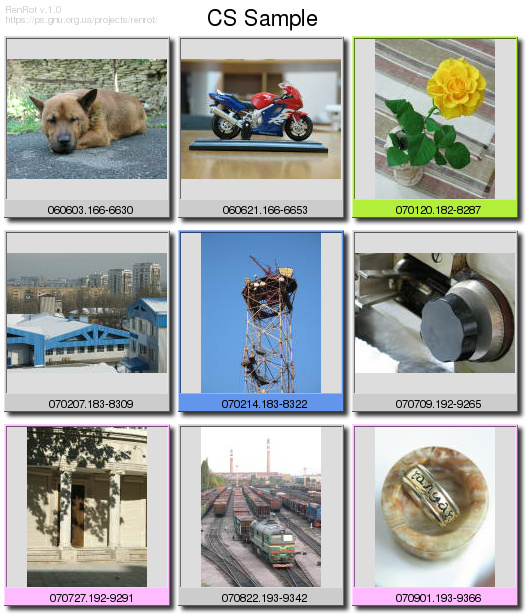3. Examples
Different aspects examples
3.1 Template examples.
3.1.1 Filename Template Examples
The name template
‘01.%c.%Y%m%d%H%M%S.%i.shtr-#ExposureTime#.f-#FNumber#.iso-#ISO#’
can produce the following names according existent EXIF tags:
| | 01.01.20030414103656.NA.shtr-1_40.f-2.8.iso-160.jpg
01.02.20040131230857.100-0078.shtr-1_320.f-2.8.iso-50.jpg
01.03.20000820222108.NA.shtr-.f-.iso-jpg
|
3.1.2 Aggregation Template Examples
Look at Aggregation examples
3.2 Aggregation examples.
3.2.1 Aggregation Examples
The following command:
| | $ renrot --aggr-mode=template --aggr-template "%Y%m%d" -e jpg
|
produces the following aggregation:
these three files
| | 01.11.20030414103656.NA.jpg
01.12.20030414103813.NA.jpg
01.13.20030414103959.NA.jpg
|
will be moved to the directory, named ‘20030414’, and
| | 01.14.20040131130857.100-0078.jpg
01.15.20040131131857.100-0079.jpg
01.16.20040131133019.100-0080.jpg
|
will be moved to the directory, named ‘20040131’.
3.2.2 Virtual Aggregation
If your file system supports links, than you can use virtual aggreagation
algorythm.
The following command:
| | $ renrot -e jpg --aggr-mode template --aggr-virtual \
--aggr-virtual-directory VIRT_AGGR_DIR
|
produces the following aggregation:
for these three files
| | 01.11.20030414103656.NA.jpg
01.12.20030414103813.NA.jpg
01.13.20030414103959.NA.jpg
|
links will be created in the directory, ‘VIRT_AGGR_DIR/20030414’, and for
| | 01.14.20040131130857.100-0078.jpg
01.15.20040131131857.100-0079.jpg
01.16.20040131133019.100-0080.jpg
|
links will be created in the directory, named ‘VIRT_AGGR_DIR/20040131’.
The very files will remain in the working directory.
3.3 Contact Sheet Generation Examples
Lets say we have these files we want to make contact sheet for:
| | $ ls -al
-rw-r--r-- 1 zeus staff 1410248 3 jun 2006 060603.166-6630.JPG
-rw-r--r-- 1 zeus staff 1119839 21 jun 2006 060621.166-6653.JPG
-rw-r--r-- 1 zeus staff 1235431 20 jan 2007 070120.182-8287.JPG
-rw-r--r-- 1 zeus staff 1307705 7 feb 2007 070207.183-8309.JPG
-rw-r--r-- 1 zeus staff 1191954 14 feb 2007 070214.183-8322.JPG
-rw-r--r-- 1 zeus staff 701277 9 jul 2007 070709.192-9265.JPG
-rw-r--r-- 1 zeus staff 1056367 27 jul 2007 070727.192-9291.JPG
-rw-r--r-- 1 zeus staff 1009504 22 aug 2007 070822.193-9342.JPG
-rw-r--r-- 1 zeus staff 702855 1 sen 2007 070901.193-9366.JPG
|
3.3.1 Contact Sheet Examples
Simple and almost default variant is:
| | $ renrot -e JPG -n '%y%m%d.%i' --cs-title 'CS Sample' --cs-tile '3x3'
|
the result of the command can be such:

In case we need to make contact sheet file for the images on the file system
we have no write access to (like the images written on the CD-ROM), than we
have to set contact sheet directory and contact sheet file manually.
| | $ renrot -e JPG --cs-dir '/tmp/CS.TMP' --cs-file 'CS.file.jpg'
|
If in renrot.rc the option ‘contact sheet dir = /tmp/CS.TMP’ was set globally,
than you can say only:
| | $ renrot -e JPG --cs-file 'CS.file.jpg'
|
3.3.2 Contact Sheet Ranking
Lets rank thumbnail images in contact sheet with colors
| | ‘70120.182-8287.JPG’ OliveDrab2
‘070214.183-8322.JPG’ CornflowerBlue
‘070727.192-9291.JPG’ plum1
‘070901.193-9366.JPG’ plum1
|
| | $ renrot -e JPG -n '%y%m%d.%i' --cs-title 'CS Sample' --cs-tile '3x3'
--cs-rank-file .rank
|
the result of the command can be such:

3.4 Tag Examples
3.4.1 Personal Info Tags
Personal information is set to XMP tags. Defaults are undefined.
| | Tag = CreatorContactInfoCiAdrCity [XMP]: 'Donetsk'
Tag = CreatorContactInfoCiAdrCtry [XMP]: 'UA'
Tag = CreatorContactInfoCiAdrExtadr [XMP]: '1 bld., Some St.'
Tag = CreatorContactInfoCiAdrPcode [XMP]: '12345'
Tag = CreatorContactInfoCiAdrRegion [XMP]: 'Donetsk'
Tag = CreatorContactInfoCiEmailWork [XMP]: 'email at some dot domain'
Tag = CreatorContactInfoCiTelWork [XMP]: '+123456789'
Tag = CreatorContactInfoCiUrlWork [XMP]: 'https://ps.gnu.org.ua/projects/renrot/'
Tag = Artist [EXIF]: 'John Doe'
Tag = ImageDescription [EXIF]: 'Just to put anything here.'
|
3.4.2 GPS Tags
For more info on GPS tags consult:
http://www.sno.phy.queensu.ca/~phil/exiftool/TagNames/GPS.html
Following sample is given for Donetsk, Ukraine:
| | Tag = GPSLatitudeRef [GPS]: 'N' # N for Noth and S for South
Tag = GPSLatitude [GPS]: '47 59 06' # in form "%d %.2f %.2f"
Tag = GPSLongitudeRef [GPS]: 'E' # E for East and W for West
Tag = GPSLongitude [GPS]: '37 46 48' # in form "%d %.2f %.2f"
Tag = GPSAltitudeRef [GPS]: 'above' # above as Above, bellow as Bellow
Tag = GPSAltitude [GPS]: '225' # in form "%d"
Tag = GPSDateStamp [GPS]: '' # in form "YYYY:MM:DD"
Tag = GPSDateStamp [GPS]: '' # in form "HH MM SS"
|
This document was generated by Zeus V Panchenko on October, 30 2009 using texi2html 1.78.


